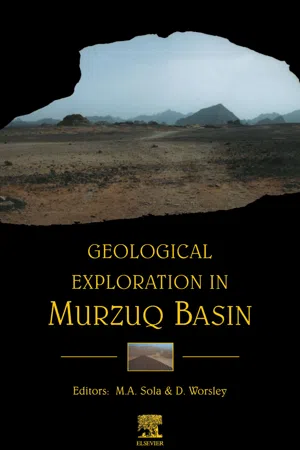
- 534 pages
- English
- PDF
- Available on iOS & Android
Geological Exploration in Murzuq Basin
About This Book
The Murzuq Basin is a large intracratonic sag basin located in southwestern Libya. Exploration efforts started in this vast and remote Saharan region already in 1957 and 60 exploratory wells have been drilled to date, resulting in over 20 discoveries with around 4, 000 million barrels of oil in place. Most discoveries have been made in Ordovician sandstone reservoirs sourced by hot shales of the Lower Silurian Tanezzuft Formation. Oil is already being produced and exported from the area, but the basin's total hydrocarbon potential is still poorly understood. Recent exploration - especially the major discovery and initial development of the Giant "Elephant" Field - has greatly increased interest for the area's potential. Many petroleum geologists and companies now believe that the basin may well develop into a new major hydrocarbon province which will significantly contribute to Europe's energy needs in the next decades.
This book presents papers from a conference held at Sebha University - on the eastern margins of the Murzug Basin - in September 1998.The book continues an ongoing series of presentations of the geology of Libya, but the 25 contributions herein mostly centre on the Murzuq Basin itself and on nearby areas. There are still many unresolved questions in terms of geological and hydrocarbon exploration in these difficult desert areas, but the papers herein will hopefully present a first comprehensive overview of an exciting frontier exploration region. About half of the papers are directly related to hydrocarbon exploration, and to source rock and reservoir development, but a wide variety of other features are also described, ranging from palaeontology and biostratigraphy to ore geology and water resources, covering the entire geological column from the Precambrian to the Holocene. The book concludes with a bibliography covering all geological aspects of this challenging but very promising frontier area.
Frequently asked questions
Information
Table of contents
- Front Cover
- Geological Exploration in Murzuq Basin
- Copyright Page
- Contents
- Preface
- Acknowledgements
- Glossary
- Chapter 1. Groundwater Salinity Variations in the Cambro-Ordovician Aquifer of Eastern Jabal al Hasawnah, the Great Man-made River Project, Libya
- Chapter 2. Magnetostratigraphy as a Potential Tool for Correlation in the Murzuq Basin Illustrated by an Example from the Triassic Snorre Reservoir in the Northern North Sea
- Chapter 3. Possible Structural Influence on the Genesis of Bir Nagaza (Al Awaynat) Radioactive Mineralisation
- Chapter 4. A Palaeontological Review of the Devonian and Carboniferous Succession of the Murzuq Basin and the Djado Sub-Basin
- Chapter 5. The Absolute Age of the Quaternary Lacustrine Limestone of the Al Mahrúqah Formation – Murzuq Basin, Libya
- Chapter 6. Carboniferous and Devonian Stratigraphy – the M'rar and Tadrart Reservoirs, Ghadames Basin, Libya
- Chapter 7. The structural development of the Murzuq and Kufra basins – significance for oil and mineral exploration
- Chapter 8. Petroleum source and reservoir rock re-evaluation in the Kufra Basin (SE Libya, NE Chad, NW Sudan)
- Chapter 9. Geology and Hydrocarbon Occurrences in the Murzuq Basin, SW Libya
- Chapter 10. Facies Models and Sequence Stratigraphy of Upper Ordovician Outcrops in the Murzuq Basin, SW Libya
- Chapter 11. Ordovician and Silurian Arthrophycid Ichonostratigraphy
- Chapter 12. Seismic Signature of the Lower Member of the Akakus Formation, Concession NC2, Ghadames Basin, Libya
- Chapter 13. Palynology of the Upper Tahara Formation in Concession NC7A, Ghadames Basin
- Chapter 14. The Structure, Stratigraphy and Petroleum Geology of the Murzuq Basin, Southwest Libya
- Chapter 15. Sedimentology and Sequence Stratigraphy of the Devonian to Lowermost Carboniferous Succession on the Gargaf Uplift (Murzuq Basin, Libya)
- Chapter 16. Stratigraphy and hydrocarbon potential of the Lower Palaeozoic succession of License NC-115, Murzuq Basin, SW Libya
- Chapter 17. Sedimentology and Cu-U mineralisation of the Upper Cretaceous Bin Affin Member, Dur Waddan, Southwestern El Haruj, Murzuq Basin, Libya
- Chapter 18. The rubidium-strontium geochronology of the Pan-African post-orogenic granites of the eastern Tibisti orogenic belt, Tibisti Massif, South-central Libya: Application to origin and tectonic evolution
- Chapter 19. Seismic expressions of depositional processes in the upper Ordovician succession of the Murzuq Basin, SW Libya
- Chapter 20. Evidence for soft-sediment deformation – the Duwaysah Slide of the Gargaf Arch, central Libya
- Chapter 21. The Lower Devonian succession of the Murzuq Basin– possible indicators of eustatic and tectonic controls on sedimentation
- Chapter 22. Palaeostress reconstruction and tectonic evolution of the Tataouine Basin (southern Tunisia)
- Chapter 23. Mud-mounds on divergent extensional and transform margins: Devonian and Cretaceous examples from southern France.
- Chapter 24. Late Ordovician glacially related depositional systems of the Gargaf Uplift (Libya) and comparisons with correlative deposits in the Taoudeni Basin (Mauritania)
- Chapter 25. A bibliography of the geology of the Murzuq Basin
- Index